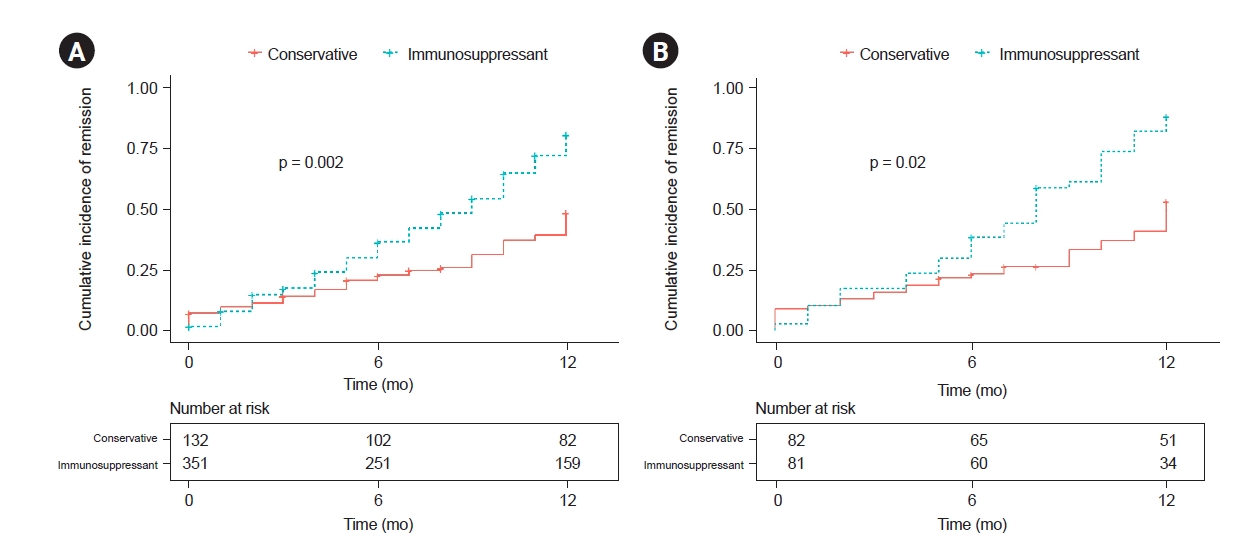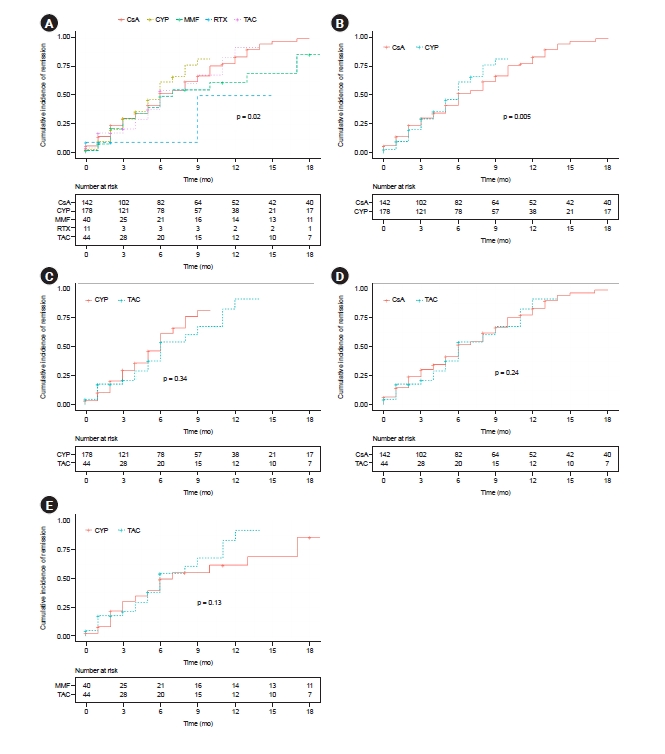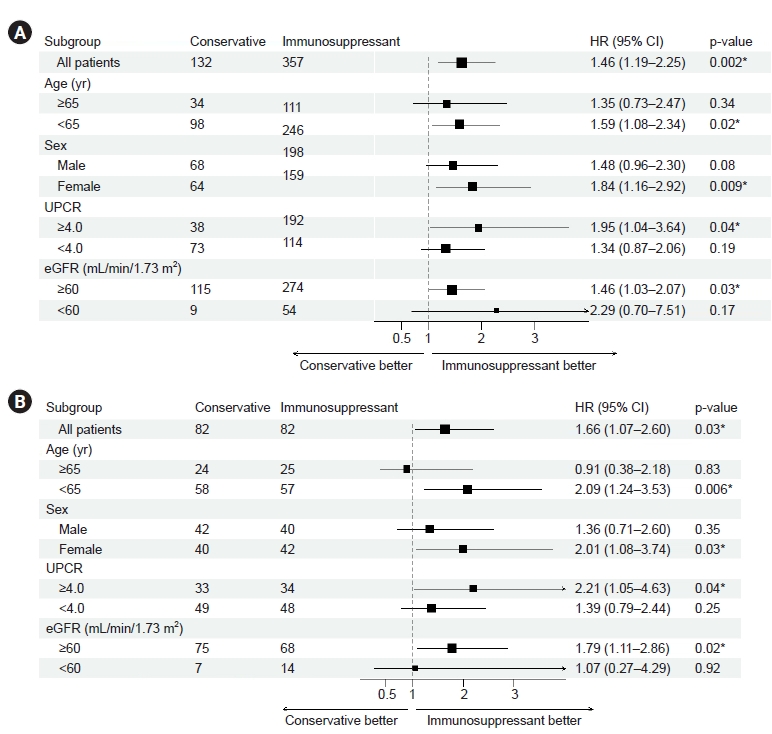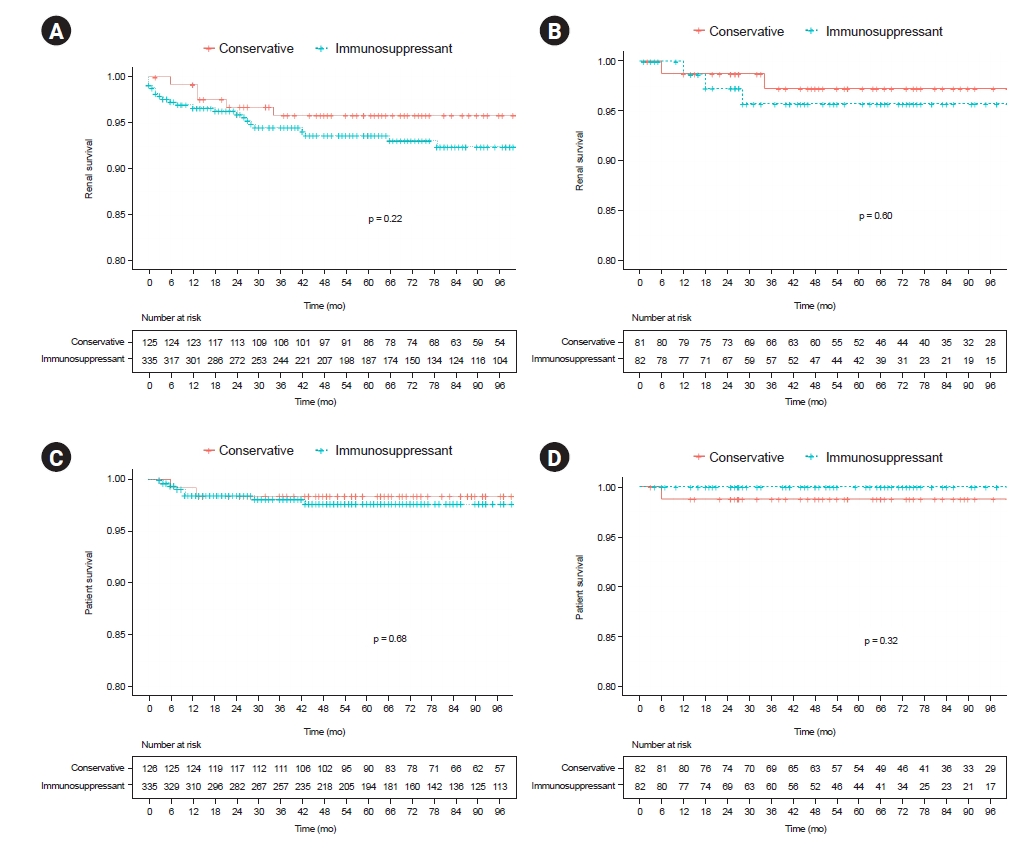| Kidney Res Clin Pract > Epub ahead of print |
Abstract
Background
Methods
Results
Notes
Funding
This work was supported by Biomedical Research Institute grant, Kyungpook National University Hospital (2016).
Supplementary Materials
Figure 1.
Cumulative incidence of complete or partial remission at 12 months between treatment groups in the total and propensity score-matched populations.

Figure 2.
Cumulative incidence of complete or partial remission by immunosuppressants.

Figure 3.
Subgroup analyses to assess the effect of immunosuppressant treatment on complete or partial remission in the total population.

Figure 4.
Renal and patient survival between treatment groups in the total and propensity score-matched populations.

Table 1.
Data are expressed as number only, number (%), or mean ± standard deviation.
ACEi, angiotensin-converting enzyme inhibitors; ARB, angiotensin receptor blocker; BP, blood pressure; eGFR, estimated glomerular filtration rate; iMN, idiopathic membranous nephropathy; LDL, low-density lipoprotein; PCR, protein-creatinine ratio; SMD, standardized mean difference.
Table 2.
| Variable |
Total population (n = 489) |
Propensity-matched population (n = 164) |
||||||
|---|---|---|---|---|---|---|---|---|
| Conservative treatment (n = 132) | Immunosuppressant treatment (n = 357) | Total (n = 489) | p-value | Conservative treatment (n = 82) | Immunosuppressant treatment (n = 82) | Total (n = 164) | p-value | |
| Any remissiona | 108 (81.8) | 320 (89.6) | 428 (87.5) | 0.003* | 71 (86.6) | 76 (92.7) | 147 (89.6) | 0.29 |
| Complete remission | 79 (59.8) | 201 (56.3) | 280 (57.3) | 49 (59.8) | 54 (66.7) | 103 (63.2) | ||
| Partial remission | 29 (22.0) | 119 (33.3) | 148 (30.3) | 22 (26.8) | 22 (27.2) | 44 (27.0) | ||
| No remission | 24 (18.2) | 31 (8.9) | 55 (11.2) | 11 (13.4) | 5 (6.2) | 16 (9.8) | ||
| Period to reach remission (mo) | 25.6 ± 31.8 | 17.3 ± 21.9 | 19.6 ± 25.2 | 0.001* | 22.2 ± 24.9 | 19.5 ± 29.1 | 20.9 ± 27.1 | 0.53 |
| End-stage renal disease | 5 (3.8) | 22 (6.2) | 27 (5.5) | 0.30 | 2 (2.5) | 3 (3.7) | 5 (3.0) | >0.99 |
| Death | 2 (1.6) | 7 (2.1) | 9 (1.8) | 0.73 | 1 (1.2) | 0 (0) | 1 (0.6) | >0.99 |
| Infection | 18 (13.6) | 78 (21.8) | 96 (19.6) | 0.03* | 9 (11.0) | 9 (11.0) | 18 (11.0) | >0.99 |
| Anti-PLA2R Ab positivityb | 1/23 (4.3) | 36/101 (35.6) | 37/124 (29.8) | 0.007* | 1/17 (5.9) | 9/23 (39.1) | 10/40 (25.0) | 0.04* |
Table 3.
| Variable | CYP (n = 182) | CsA (n = 158) | TAC (n = 51) | MMF (n = 44) | RTX (n = 16) |
|---|---|---|---|---|---|
| Remission | 131 (72.0) | 122 (77.2) | 31 (60.8) | 25 (56.8) | 4 (25.0) |
| Complete remission | 79 (43.4) | 78 (49.4) | 18 (40.9) | 8 (20.0) | 2 (18.2) |
| Partial remission | 52 (28.6) | 44 (27.8) | 13 (29.5) | 17 (42.5) | 2 (18.2) |
| No remission | 47 (25.8) | 35 (22.2) | 13 (29.5) | 15 (37.5) | 7 (63.6) |
| Time to reach remission (mo)* | 8.2 ± 12.2 | 13.5 ± 16.2 | 10.4 ± 12.7 | 12.7 ± 16.7 | 11.4 ± 18.5 |
| End-stage renal disease* | 9 (5.5) | 6 (3.9) | 2 (3.9) | 4 (9.3) | 2 (13.3) |
| Death* | 6 (3.6) | 1 (0.6) | 1 (2.0) | 0 (0) | 0 (0) |
| Infection* | 51(28.0) | 32 (20.3) | 12 (23.5) | 7 (15.9) | 5 (31.3) |
References
- TOOLS
-
METRICS

-
- 0 Crossref
- 0 Scopus
- 962 View
- 45 Download
- ORCID iDs
-
Ji-Young Choi

https://orcid.org/0000-0002-9774-3665Ho Jun Chin

https://orcid.org/0000-0003-1185-2631Hajeong Lee

https://orcid.org/0000-0002-1873-1587Yena Jeon

https://orcid.org/0000-0002-4857-8616Jeong-Hoon Lim

https://orcid.org/0000-0001-5517-9886Hee-Yeon Jung

https://orcid.org/0000-0003-0232-7202Jang-Hee Cho

https://orcid.org/0000-0002-7031-5214Chan-Duck Kim

https://orcid.org/0000-0002-4648-0324Yong-Lim Kim

https://orcid.org/0000-0002-1344-3455Sun-Hee Park

https://orcid.org/0000-0002-0953-3343 - Related articles
-
Nonimmunologic targets of immunosuppressive agents in podocytes2015 June;34(2)



 PDF Links
PDF Links PubReader
PubReader ePub Link
ePub Link Full text via DOI
Full text via DOI Download Citation
Download Citation Supplement table 1
Supplement table 1 Print
Print















